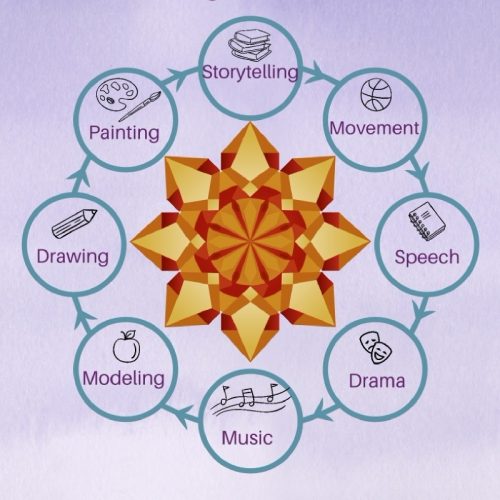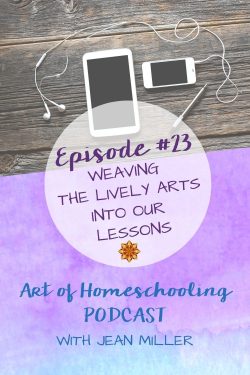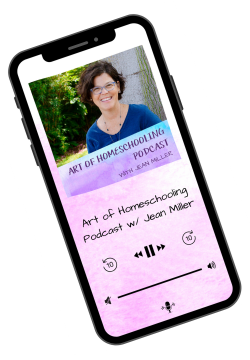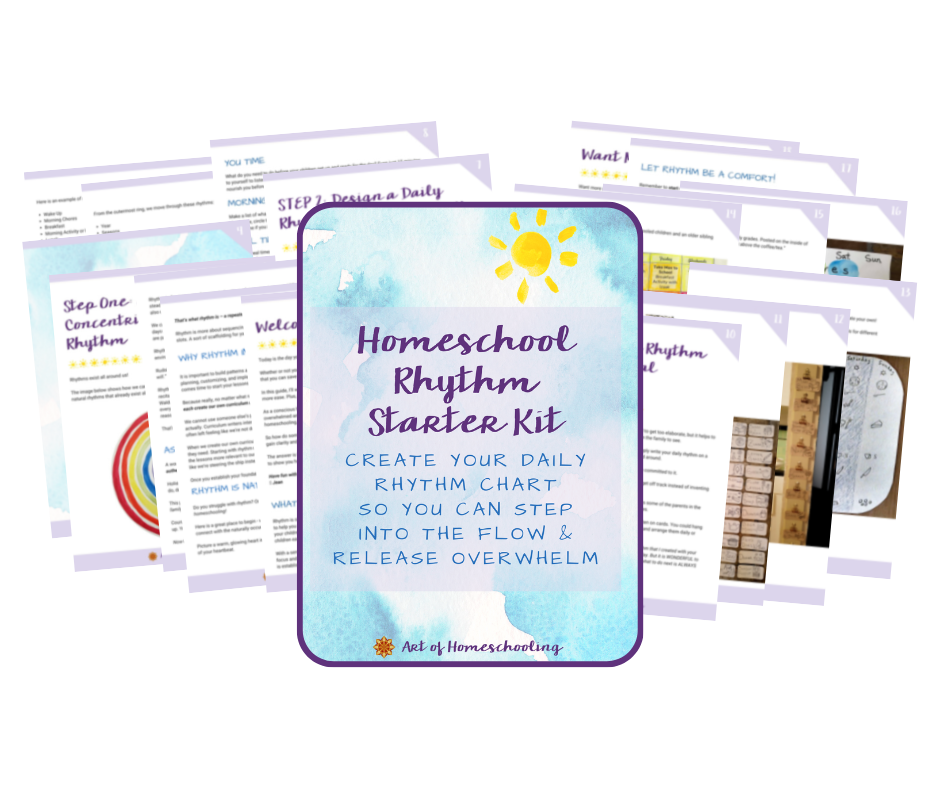Episode 23
Have you ever wondered WHY the Waldorf approach is built around the arts? I honestly think it’s this unique way of creating lessons that draws many of us to this approach – the lively arts homeschool lessons.
I’ve homeschooled three of my now-grown kids inspired by the Waldorf approach.
And when I first heard the term “lively arts”, I became fascinated.
Let’s dive into the why behind the arts. And stick with me as I’ll share some ways you can explore weaving the lively arts into your lessons.
Many years ago, like in the early 1990s, I attended the very first Waldorf Homeschooling Conference in Ann Arbor Michigan. The event was organized by Rahima Baldwin, author of You Are Your Child’s First Teacher – a fabulous book that I highly recommend. (That’s an affiliate link for your convenience which just means if you click through and purchase, I may get a small commission at no extra cost to you.)
At that conference in 1993, I first heard the term “the seven lively arts.”
I was intrigued. So I did some research and here’s what I discovered:
Back in 1919 when Rudolf Steiner founded of the very first Waldorf school, he set out to design a curriculum that would bring about social and economic renewal in a country that had been torn apart by World War I.
He did NOT set out to create a movement. But rather, he set out to design ONE school based around a new method, a new way of learning.
After visiting schools and classrooms all over Europe, he came to the conclusion that the system of education was based very much on a teacher lecturing while the students recorded notes in their notebooks.
Not so unfamiliar to us today, right!?!
Steiner felt like this way of teaching and learning was WAY too abstract and made the learning very dry. So, his main goal with the first Waldorf School was to develop a new way of teaching that would combat the abstract.
In fact, he actually said that teaching itself is an art.
“The heart of the Waldorf method is the conviction that education is an art – it must speak to the child’s experience. To educate the whole child, his heart must be reached as well as his mind.” ~Rudolf Steiner
So Steiner set out to organize a school where the lessons were hands-on and engaging. And he designed an entire method around the arts.
Why? Because he said that the arts bring us joy and make the learning more memorable!
At some point, Steiner’s followers started talking about the concept of the lively arts. Here’s how that evolved.
In Ancient Times, a true scholar was a person who studied the Liberal Arts. The Liberal Arts were the set of subjects that when mastered made a person (of course back then, usually a man) a scholar. Things like mathematics, rhetoric, and astronomy. And Steiner saw these liberal arts being carried forward into the modern teaching of his times, and again, he saw that they contributed to abstract teaching and learning. He felt the teaching method of lecture and notetaking, as well as studying liberal arts subjects had become so abstract.
Steiner wanted to transform abstract teaching and learning into a more lively experience for children.
So, over 100 years ago, Steiner developed the Waldorf approach based on the Lively Arts as its foundation rather than the liberal arts.
The Lively Arts include: Movement, Speech, Drama, Music, Modeling, Drawing, and Painting.
These arts bring the learning alive, bring us and our children joy, and help to make the learning more memorable.
Now, there is also the art of Storytelling which is the most important art of all really. And you may notice it missing from this list. In the Waldorf method, storytelling is how all NEW material is presented.
All the way from the early years through 8th grade, even into high school. Think about it, stories help us to connect with each other, with new ideas, and help us to remember events and people.
So I like to say the Waldorf approach is based on, “The Seven Lively Arts Plus One” with the plus one being storytelling.
The lively arts include active and engaging artistic activities that actually help us teach any and all subjects to our children.
And that was Steiner’s intent back in 1919.
Steiner’s aim was to graduate students who would “be able in and of themselves to impart purpose and direction to their lives.”
Now I want to share with you how you can weave the lively arts into your homeschool to help bring the learning alive and make deeper connections with your children.
How to Weave the Lively Arts Into Your Lessons
Here’s a wonderful image of the lively arts.

When I started helping homeschooling moms, I wanted to create a logo for my business. And I took a picture of this golden-yellow folded paper window star that I’d made that was hanging in our dining room window. That star became my logo. And a few years later, when I set out to design an image for the lively arts, I discovered the star had 8 points and there were 8 lively arts! A fun moment of synergy. ?
Want to download an article with creative ideas for each of the Lively Arts? Just enter your name and email below.
So let’s get practical and see how you might weave some of these hands-on engaging activities into your homeschooling lessons.
First I suggest you choose one of the lively arts to focus on for awhile – that’s right, just ONE.
To begin to narrow it down, I suggest my mantra
“Think in threes, pick one.”
Perhaps you’re interested in exploring movement, music, and painting. Which one do you want to start with? Music you say? Perhaps you could add a “call to lessons song” that you either sing or play on a musical instrument you have on hand – piano or recorder. Choose a simple song that you can learn easily and make it the same every time you want to call children to lessons. That way, it becomes a signifier, like a little recognizable ritual that signals time to begin.
Or perhaps you want to add in a song to sing together as a family before meals. Or a nighttime lullaby. Or a song from a culture that you’re studying in your geography block or ancient history block.
It can really help to think of focusing on this one lively art for the next month or so, giving everyone a chance to really explore. And giving you a chance to see that you’re making progress!
Here are a few other ideas:
- Start introducing all new topics or blocks with great storytelling – either your own or finding a wonderful author who weaves beautiful tales.
- Bring stories to your holiday or seasonal celebrations.
- Turn one of those stories into a puppet play.
- Find a new poem to learn by heart that’s related to the season or your lesson block topic.
- While reciting the new poem, clap to the rhythm or toss bean bags – this will help you learn it by heart even faster!
- Add movement to learning math facts.
- Make a main lesson book of drawings and summaries of the stories you share.
- Schedule a painting day at the beginning of each month to paint a picture of the seasonal changes outside your window.
Can you see how once you start considering ideas, they really start to flow!?!
And if you want support in homeschooling with the lively arts, I invite you to come join me and a wonderful community of homeschoolers inside Inspired at Home. With this membership, you get access to over 20 masterclasses on all aspects of the Waldorf approach, along with weekly small group coaching calls and planning support. You can check out details about the membership community here.
Above all, have fun weaving the lively arts into your lessons.
Rate & Review
If this episode inspired you, I’d LOVE it if you could rate and review the Art of Homeschooling Podcast on your favorite podcast player! Reviews can be left on Apple Podcasts (iTunes), Podcast Addict, or Stitcher.
Or simply pop on over to lovethepodcast.com/artofhomeschooling and choose where you want to leave your review.
And if you want to show your appreciation for the Art of Homeschooling Podcast, you can buy me a coffee!
Never Miss an Episode!
Follow & Listen:
Check Out All the Episodes Here (<<< Click that link!)
Save or share this episode on Pinterest with the image below.




